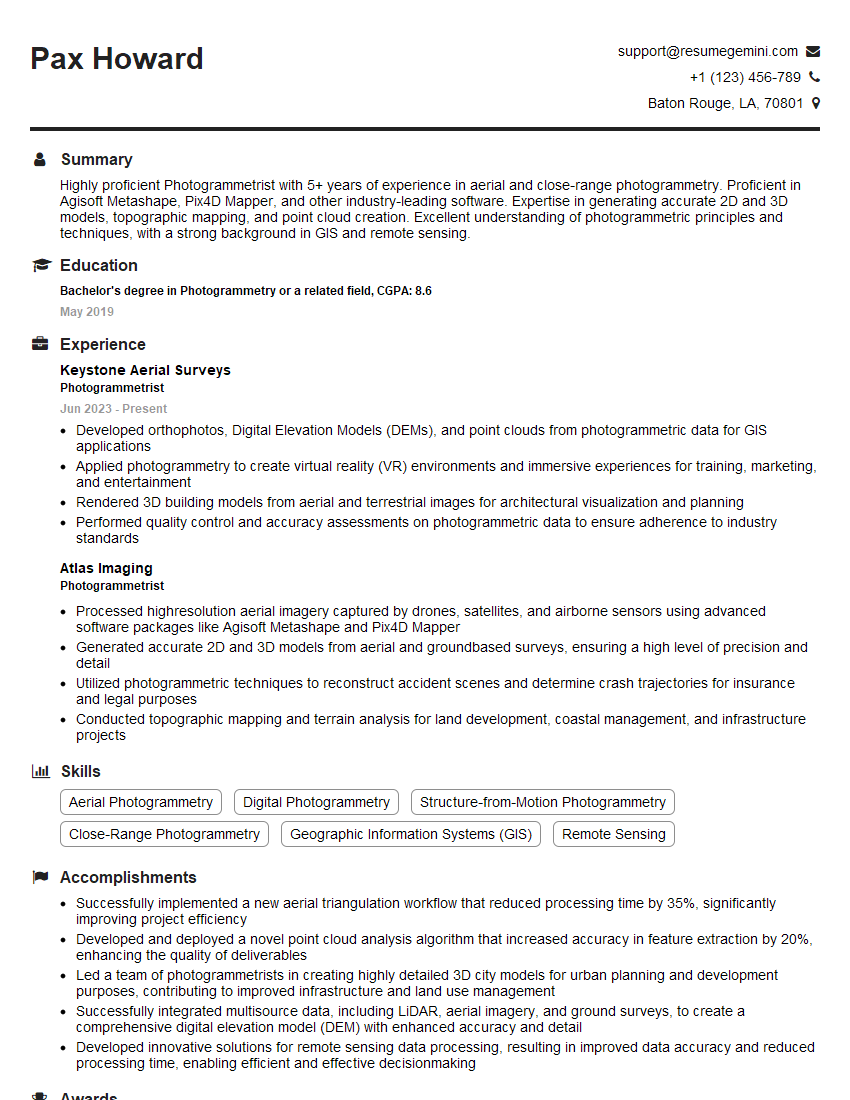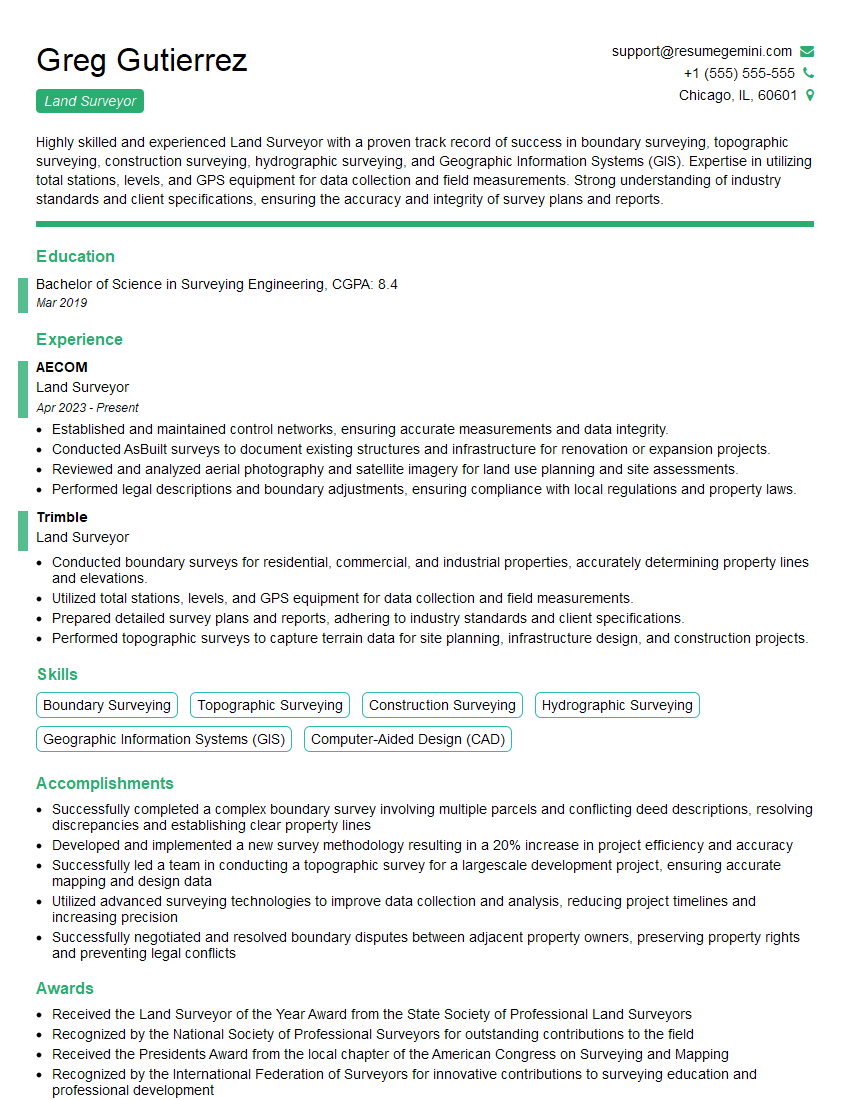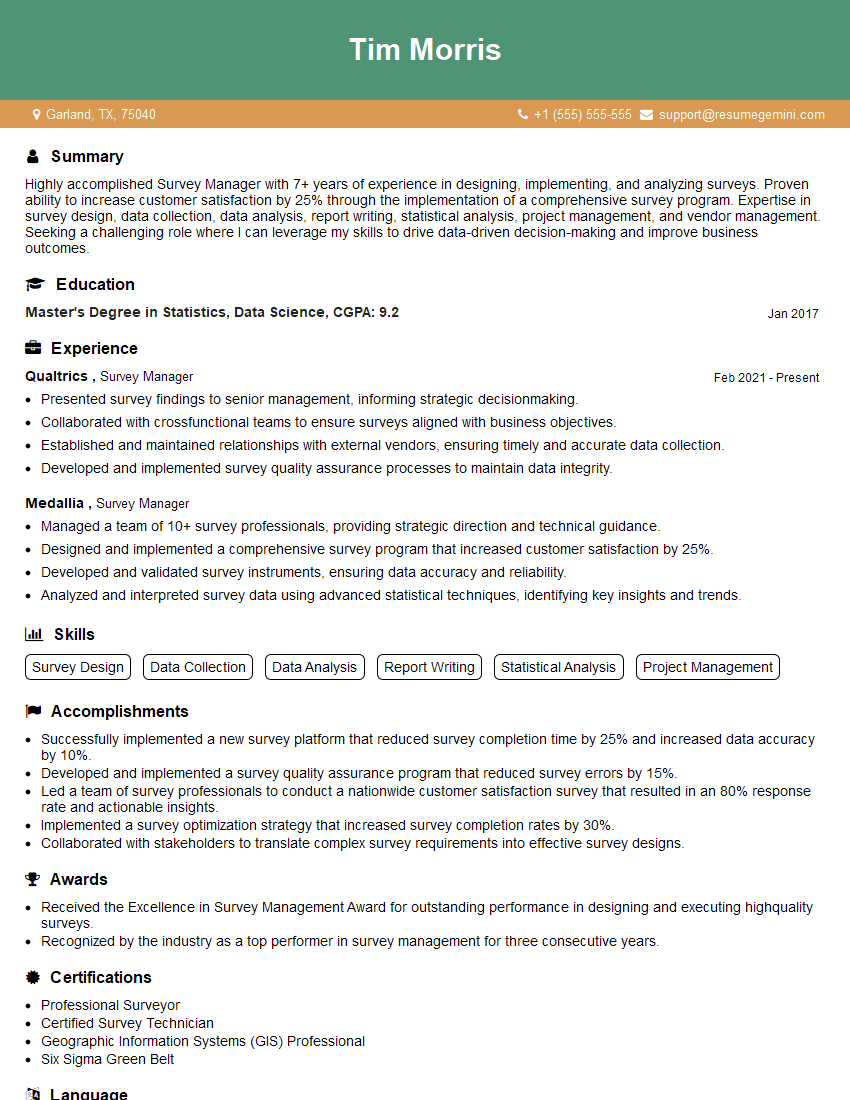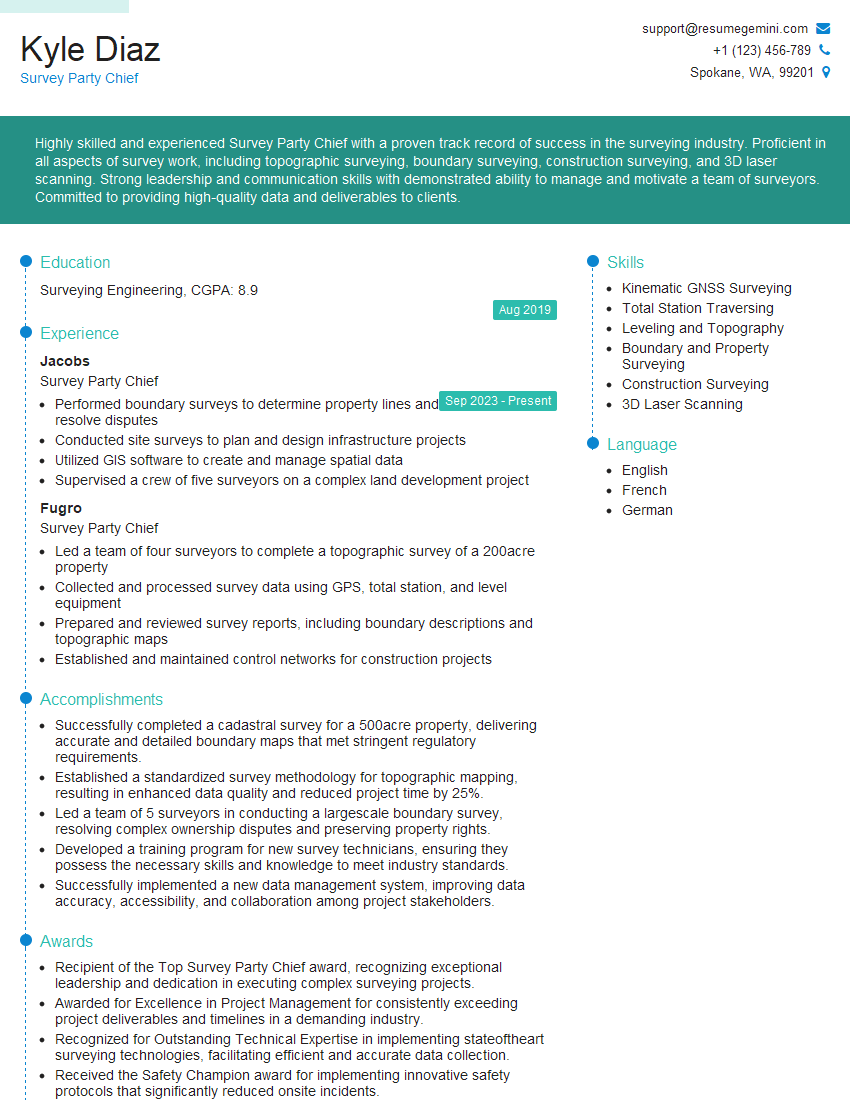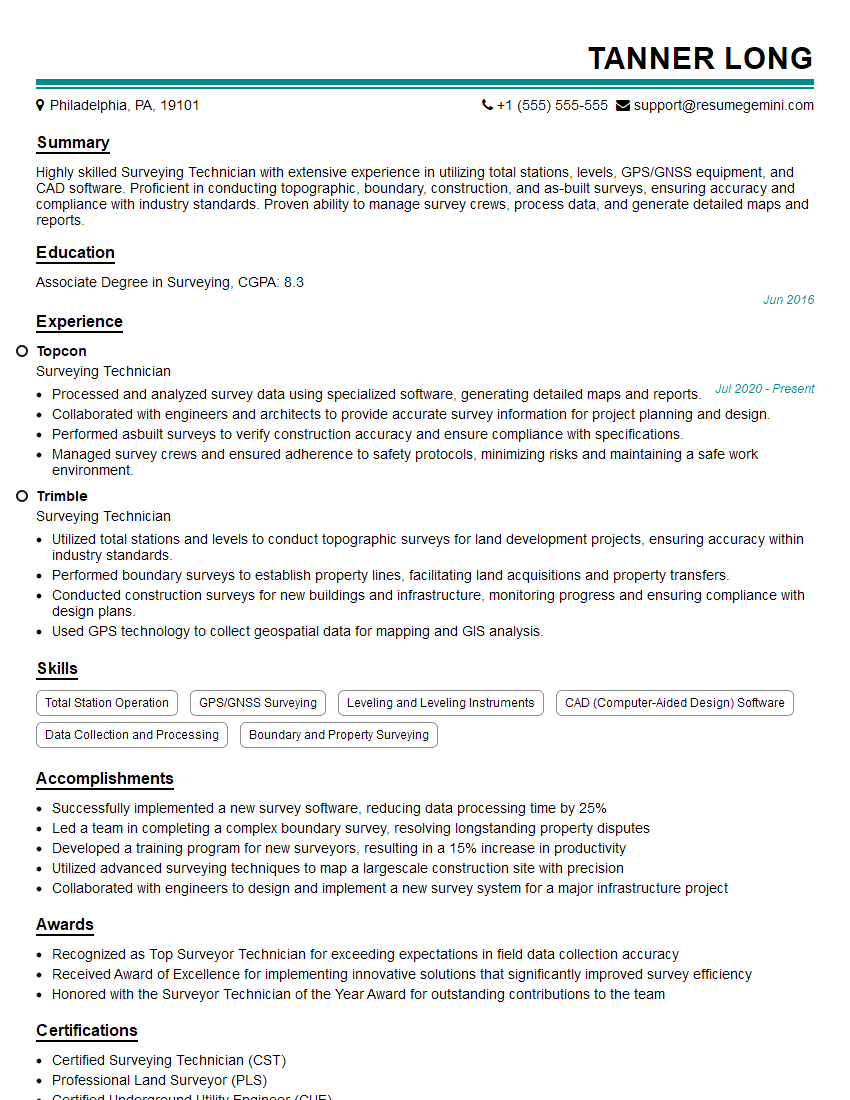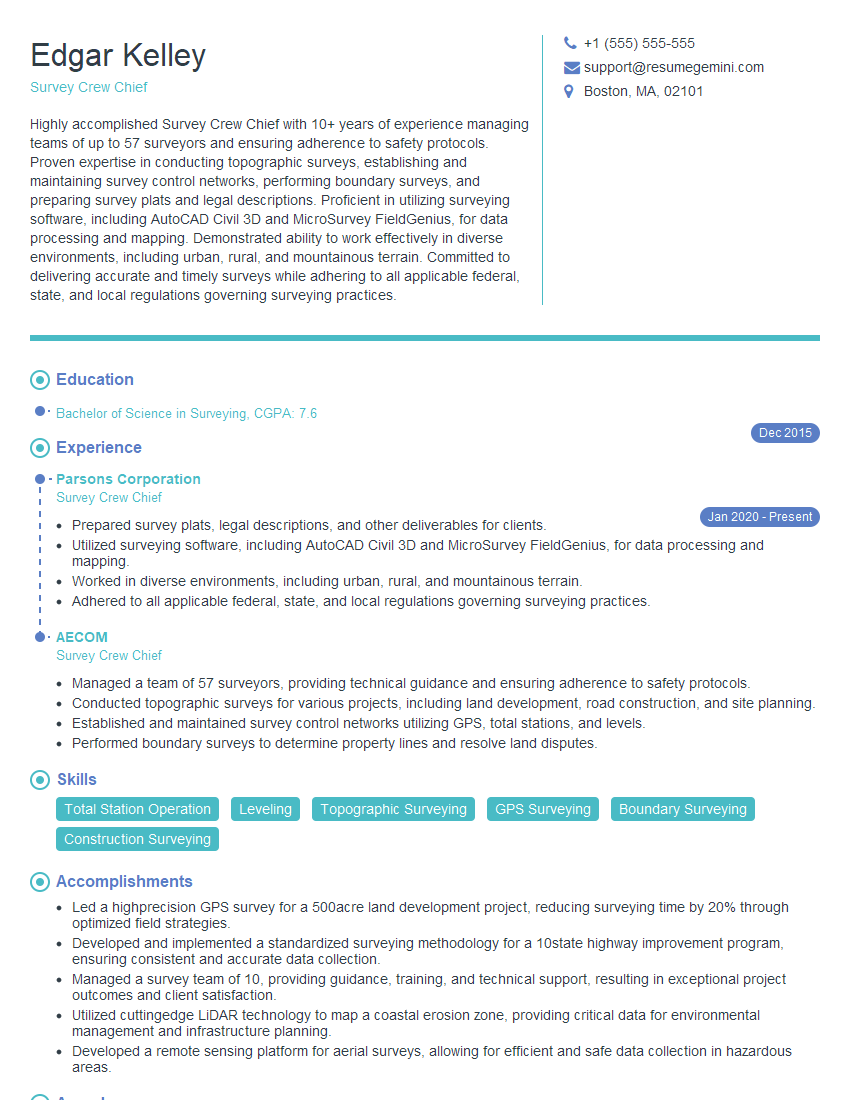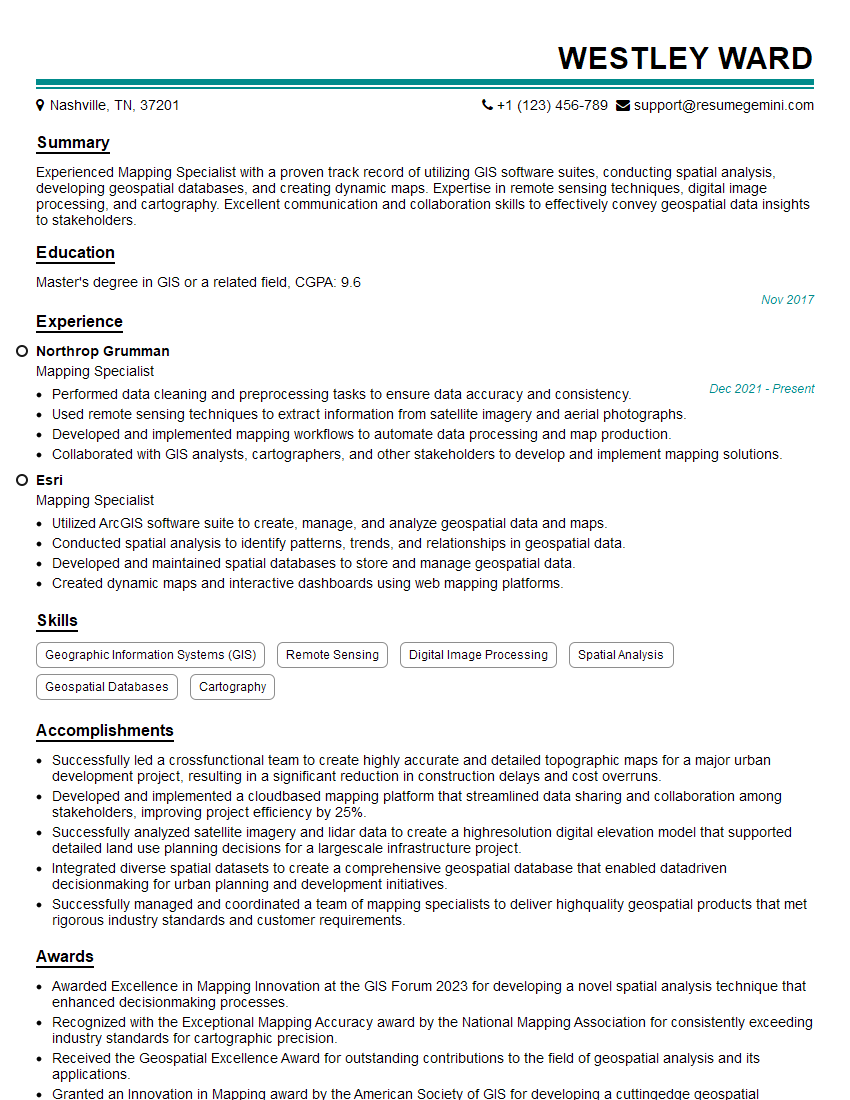Preparation is the key to success in any interview. In this post, we’ll explore crucial Experience in using GPS and surveying equipment interview questions and equip you with strategies to craft impactful answers. Whether you’re a beginner or a pro, these tips will elevate your preparation.
Questions Asked in Experience in using GPS and surveying equipment Interview
Q 1. Explain the difference between GPS and GNSS.
GPS, or Global Positioning System, refers to the specific satellite-based navigation system operated by the United States. GNSS, or Global Navigation Satellite System, is a broader term encompassing all global and regional satellite-based positioning systems, including GPS, GLONASS (Russia), Galileo (Europe), and BeiDou (China). Think of it like this: GPS is one brand of car, while GNSS is the entire category of cars.
Using multiple GNSS constellations provides increased accuracy and availability, especially in challenging environments where signals from one system might be obstructed. For example, in a dense urban canyon, signals from GPS satellites might be blocked by buildings, but signals from Galileo or BeiDou might still be received, providing a more robust positioning solution.
Q 2. Describe the various types of surveying equipment you are familiar with.
My experience encompasses a wide range of surveying equipment, both traditional and modern. This includes:
- Total Stations: These robotic instruments measure distances and angles with high precision, providing accurate coordinates for points in a survey. They are crucial for creating detailed topographic maps and setting out construction projects.
- GPS Receivers (various types): From handheld units for quick location checks to high-precision geodetic receivers used for base station and rover operations, my expertise covers the spectrum. These are essential for large-scale mapping projects and precise positioning.
- Levels: Optical and digital levels are used for establishing precise elevations, crucial for grading, construction, and engineering projects. Think of these as highly accurate measuring tools for vertical dimensions.
- Data Collectors: These handheld devices are used to record and manage data from various surveying instruments. They often have robust software for data processing and quality control.
- EDM (Electronic Distance Measurement) equipment: This is integrated into total stations and some GPS receivers. It uses electromagnetic waves to measure distances accurately.
I’m also proficient in using software for data processing and analysis, such as AutoCAD Civil 3D and other GIS applications.
Q 3. What are the common sources of error in GPS surveying?
GPS surveying is susceptible to several error sources. These can be broadly categorized as:
- Atmospheric Effects: Ionospheric and tropospheric delays affect signal propagation, causing errors in positioning. The atmosphere acts like a lens, bending the satellite signals.
- Multipath Errors: Signals reflecting off surfaces like buildings or water bodies reach the receiver after traveling different paths, leading to inaccurate measurements. This is like hearing an echo that distorts the original sound.
- Satellite Geometry (GDOP): Poor satellite geometry, where satellites are clustered together in the sky, results in weaker positioning solutions. Imagine trying to locate yourself using only three points that are very close together.
- Receiver Noise: Electronic noise in the receiver can interfere with signal processing and cause inaccuracies.
- Orbital Errors: Imperfect knowledge of satellite orbits introduces errors into the positioning calculations.
- Satellite Clock Errors: Inaccuracies in the satellite clocks also contribute to positioning errors.
Understanding and mitigating these errors is critical for achieving high-accuracy results.
Q 4. How do you handle multipath errors in GPS data?
Multipath errors are addressed through several techniques. One common approach is to use advanced signal processing algorithms within the receiver. These algorithms analyze the received signals and attempt to identify and reject multipath reflections. This is often done through correlation techniques to identify the primary signal and filter out the others.
Careful site selection also plays a role. Avoid taking measurements in areas with many potential reflecting surfaces. If unavoidable, consider using techniques like antenna shielding or employing a different measurement approach, such as using a total station instead of solely relying on GPS.
Additionally, data post-processing techniques can help detect and reduce multipath errors by using advanced filtering and smoothing algorithms.
Q 5. Explain the concept of Differential GPS (DGPS).
Differential GPS (DGPS) significantly improves the accuracy of GPS positioning by correcting for errors inherent in standard GPS measurements. It works by using a base station receiver at a known location with high accuracy (often surveyed using precise methods). This base station continuously monitors the same satellites as the rover receiver (the receiver taking the measurements in the field).
The base station calculates the difference between its known position and the GPS-derived position. These corrections are then transmitted to the rover receiver via radio waves or a communication link. The rover receiver then applies these corrections to its raw GPS measurements, substantially reducing errors. This is like having a reference point to adjust your measurements, increasing overall precision significantly.
DGPS can achieve centimeter-level accuracy, far surpassing the accuracy of standalone GPS.
Q 6. What are the different coordinate systems used in surveying?
Surveying uses several coordinate systems, each with its purpose and projection method. The choice of system depends on the project’s scale, location, and application.
- Geographic Coordinate System (GCS): Uses latitude and longitude to define locations on the Earth’s surface. This is essentially using a spherical coordinate system. A common example is WGS84.
- Projected Coordinate System (PCS): Projects the curved Earth’s surface onto a flat plane, allowing for distance and area calculations that are more straightforward. Examples include UTM (Universal Transverse Mercator) and State Plane Coordinate Systems.
- Local Coordinate Systems: These are arbitrary systems established for specific projects, often using a local origin point and specific directions and units. These are useful when working on localized projects.
Transformations between these systems are frequently necessary during projects.
Q 7. How do you perform a traverse survey?
A traverse survey involves establishing a network of connected lines (traverses) to determine the relative positions of points. This is a common method used for mapping and establishing control points for other surveys.
Steps involved in performing a traverse survey:
- Reconnaissance: Planning the survey route, considering terrain, accessibility, and the overall project goals.
- Establish Control Points: Setting up known points (possibly using GPS or existing control points) as starting points for the traverse.
- Measure Angles and Distances: Using a total station, measure the horizontal and vertical angles at each point, along with the distances between successive points.
- Data Recording: Recording all measurements in a field book or data collector, ensuring accurate notations.
- Data Processing: Applying adjustments to the measurements to account for errors in measurement, using software and computation methods such as least squares adjustment.
- Coordinate Calculation: Computing the coordinates of each point within the traverse network. Typically this involves using coordinate geometry techniques.
- Error Analysis: Analyzing the accuracy and precision of the survey results and determining if any adjustments are needed.
- Mapping/Reporting: Generating maps, drawings, or reports documenting the survey results and findings.
Traverse surveys are fundamental for various applications, from creating topographic maps to setting out buildings and infrastructure.
Q 8. Explain the process of leveling.
Leveling is a fundamental surveying technique used to determine the difference in elevation between two or more points. It’s like finding the slope of a hill, but with precise measurements. We use a level, an instrument that provides a horizontal line of sight, and a leveling rod, a graduated staff held vertically at the points we want to measure.
The process involves setting up the level approximately midway between two points. We sight the leveling rod at the first point, reading the height. Then, we move the rod to the second point and repeat the reading. The difference between these two readings, after accounting for the instrument’s height, gives us the difference in elevation. For longer distances or greater accuracy, we establish a series of intermediate points, a process called ‘flying levels’, creating a continuous elevation profile.
Example: Imagine surveying a building site. Leveling helps us establish a benchmark – a known elevation – from which we can determine the elevations of all other points on the site, ensuring accurate foundations and construction.
Q 9. Describe your experience with total station instruments.
I have extensive experience with total station instruments, using them for various tasks, including traversing, setting out, and detail surveys. Total stations are highly accurate electronic instruments that measure both angles and distances. They combine the functions of a theodolite (for measuring angles) and an electronic distance meter (EDM).
My experience includes using total stations for setting out buildings and infrastructure projects, where precise positioning is critical. I’m proficient in using different measurement modes, such as robotic total stations, which automatically track the prism, increasing efficiency. I’m also comfortable with data downloading and processing the point cloud data from the instrument.
Example: On a recent highway project, we used a total station to precisely locate the position of survey markers along the route. The accuracy of these measurements was crucial for the smooth construction of the road.
Q 10. How do you perform a boundary survey?
A boundary survey accurately defines the limits of a property. It’s a meticulous process that requires a thorough understanding of land tenure, legal descriptions, and surveying principles. The process typically involves:
- Reviewing legal documents: This includes deeds, titles, and other relevant records to understand the property’s legal description and history.
- Field reconnaissance: Physically inspecting the property to locate existing markers, fences, and other evidence of boundary lines.
- Establishing control points: Setting up reference points with known coordinates to provide a basis for accurate measurements.
- Measuring boundary lines: Using GPS, total stations, or other suitable equipment to measure the precise location of the boundaries.
- Monumentation: Permanently marking the boundary corners with durable markers, ensuring future reference.
- Preparing a boundary survey plat: Creating a detailed map showing the property boundaries, along with relevant information such as bearings, distances, and areas.
Example: I recently conducted a boundary survey for a client who was planning to subdivide their land. The accurate determination of the property lines was critical for ensuring the legal and efficient subdivision of the property.
Q 11. What software are you proficient in for data processing and analysis?
I am proficient in several software packages for data processing and analysis. These include:
- AutoCAD Civil 3D: For creating and managing digital terrain models (DTMs), designing alignments, and producing construction drawings.
- ArcGIS: For geospatial data management, analysis, and mapping. This is particularly useful for integrating survey data with other geographic information.
- Trimble Business Center: For post-processing RTK GPS data and generating accurate coordinates.
- MicroStation: Another powerful CAD software package, particularly useful for larger infrastructure projects.
My skills encompass data import, manipulation, analysis, and report generation using these platforms.
Q 12. Explain your experience with data collection and post-processing techniques.
My experience encompasses the entire data collection and post-processing workflow. Data collection often begins with planning the survey, determining the appropriate equipment and techniques. In the field, I use various instruments such as total stations, GPS receivers, and levels to collect raw data. Data is carefully checked for inconsistencies and errors in the field to minimize later issues.
Post-processing involves importing the raw data into specialized software. This involves coordinate transformations, error correction, and data analysis to produce accurate maps, plans, and reports. For RTK GPS data, post-processing is crucial to achieve centimeter-level accuracy.
Example: In a recent topographic survey, we used RTK GPS to collect elevation data across a large area. The raw data was then processed in Trimble Business Center to correct for atmospheric and satellite effects, resulting in a highly accurate digital terrain model.
Q 13. How do you ensure accuracy and precision in your surveying work?
Ensuring accuracy and precision is paramount in surveying. This involves a multi-pronged approach:
- Calibration and Maintenance: Regularly calibrating instruments and performing preventative maintenance is essential. This ensures that the equipment is functioning optimally.
- Redundant Measurements: Taking multiple measurements of the same feature helps identify and mitigate errors. The consistency of results reveals accuracy.
- Proper Techniques: Following established surveying procedures and utilizing best practices minimizes errors during data acquisition.
- Quality Control Checks: Implementing thorough quality control procedures at each stage of the workflow identifies and corrects errors early on.
- Data Validation: Rigorous data analysis and validation using software ensures data integrity before finalizing any reports.
Example: During a construction layout, we used both total station and GPS measurements to verify the positions of key points. This cross-checking ensured that any discrepancies were identified and rectified before construction began.
Q 14. Describe your experience with RTK GPS.
Real-Time Kinematic (RTK) GPS is a technology that provides highly accurate positioning data in real-time. It uses a network of base stations and roving receivers to correct for errors caused by atmospheric conditions and satellite geometry. I have extensive experience in using RTK GPS for various applications, including:
- High-precision mapping: Creating detailed topographic maps with centimeter-level accuracy.
- Construction layout: Accurately positioning construction elements, ensuring that buildings and infrastructure are constructed to the correct specifications.
- Machine control: Guiding heavy machinery like excavators and bulldozers with precision.
Example: On a recent project, we used RTK GPS to survey the alignment of a new pipeline. The high accuracy of the RTK system was crucial for ensuring the pipeline’s correct placement and minimizing excavation work.
Q 15. What are the safety procedures you follow in the field?
Safety is paramount in fieldwork. My procedures begin with a thorough pre-job briefing covering site-specific hazards like uneven terrain, traffic, wildlife, and weather forecasts. I always wear high-visibility clothing and appropriate personal protective equipment (PPE), including safety boots, hard hats, and high-visibility vests. Before starting any task, I perform a site inspection to identify and mitigate potential risks. I ensure I have adequate communication devices, including a two-way radio and a charged mobile phone for emergencies. I always work with a buddy system, especially in remote or hazardous locations. If working near traffic, I utilize traffic control measures or work outside of peak hours. Finally, I meticulously document all safety procedures followed and any incidents, however minor, in a daily field log.
For example, during a recent survey near a busy highway, we implemented a traffic control plan with cones and warning signs before starting the work. This minimized risk to both our team and the public.
Career Expert Tips:
- Ace those interviews! Prepare effectively by reviewing the Top 50 Most Common Interview Questions on ResumeGemini.
- Navigate your job search with confidence! Explore a wide range of Career Tips on ResumeGemini. Learn about common challenges and recommendations to overcome them.
- Craft the perfect resume! Master the Art of Resume Writing with ResumeGemini’s guide. Showcase your unique qualifications and achievements effectively.
- Don’t miss out on holiday savings! Build your dream resume with ResumeGemini’s ATS optimized templates.
Q 16. How do you handle challenging terrain or weather conditions during surveying?
Challenging terrain and weather demand adaptability and careful planning. For steep slopes, we use appropriate safety measures such as ropes and harnesses. In areas with dense vegetation, we clear pathways carefully, being mindful of potential hazards like snakes or insects. We use all-terrain vehicles (ATVs) or four-wheel-drive vehicles when appropriate and safe. In adverse weather, we prioritize safety by postponing fieldwork if conditions are too dangerous. We monitor weather reports closely and have contingency plans in place, such as shelter options, and may utilize different equipment or techniques to enhance accuracy in poor visibility.
During a survey in mountainous terrain, we used specialized GPS receivers with higher sensitivity to receive signals even in areas with limited satellite visibility. We also strategically planned our survey points to minimize exposure to hazardous slopes.
Q 17. Explain your experience with different types of GPS antennas.
My experience encompasses various GPS antenna types, each suited to different applications. I’ve worked with geodetic antennas for high-precision surveying, which offer superior accuracy and are crucial for base station setups. These antennas are often larger and more sensitive. For more mobile applications, I frequently use smaller, lighter survey-grade antennas. I also have experience with dual-frequency antennas, which help mitigate atmospheric delays and multipath errors, improving accuracy. In some projects, I’ve used choke ring antennas to minimize multipath reflections from surrounding structures.
The choice of antenna depends heavily on the project requirements. For example, a high-precision cadastral survey would demand a geodetic antenna, whereas a topographic survey might utilize a lighter, more portable survey-grade antenna.
Q 18. How do you manage data integrity and quality control?
Data integrity and quality control are paramount. My workflow begins with rigorous pre-field checks of equipment calibration and functionality. During data collection, I implement redundancy by taking multiple measurements at each point and using independent quality checks within the equipment. Post-processing involves thorough error detection and correction, including outlier removal and adjustment computations. I use statistical analysis to assess data accuracy and precision. All data is carefully backed up, and a comprehensive chain of custody is maintained throughout the process. Finally, I produce detailed reports that document all procedures, analyses, and quality control measures.
Imagine a scenario where a single bad measurement could affect the entire survey; rigorous quality control procedures prevent such situations.
Q 19. Describe your experience with GIS software and its applications in surveying.
I’m proficient in various GIS software packages, including ArcGIS and QGIS. I use these tools to process and analyze survey data, create maps, perform spatial analyses, and generate reports. GIS software is instrumental in visualizing survey data, identifying patterns, and making informed decisions. For instance, I used ArcGIS to create detailed topographic maps from survey data, and then performed spatial analysis to determine optimal locations for infrastructure development. QGIS has been helpful for managing large datasets and integrating survey data with other spatial data layers.
GIS software extends the value of the survey data far beyond the raw numbers by enabling spatial reasoning and decision-making in various applications, from urban planning to environmental management.
Q 20. Explain the principles of coordinate transformation.
Coordinate transformation is the process of converting coordinates from one coordinate system to another. This is crucial because different surveys may use different datums, projections, or units. The process involves using mathematical formulas and parameters to accurately convert the coordinates. Common transformations include datum transformations (e.g., converting between NAD83 and WGS84) and map projections (e.g., converting between UTM and geographic coordinates). These transformations rely on specific parameters which often involve the use of software and readily available online resources.
For instance, converting coordinates from a local state plane coordinate system to a global geodetic system like WGS84 requires a specific transformation using parameters that define the relationship between the two systems. This is commonly done using specialized software like coordinate transformation utilities.
Q 21. How do you calculate areas and volumes from survey data?
Calculating areas and volumes from survey data often involves the use of computational geometry techniques. For area calculations, methods like the trapezoidal rule or more sophisticated algorithms are employed depending on the complexity of the polygon. For irregular polygons, we use coordinate geometry methods to calculate the area using the coordinates of the vertices. Volume calculations usually require three-dimensional data. This often involves breaking the volume into smaller prisms or using numerical integration techniques. Software packages designed for surveying and GIS provide tools to automate these calculations.
For example, to calculate the volume of an earthwork, I might use a software package that takes the survey data points and generates a three-dimensional model. The volume of the cut or fill is then readily calculated by the software.
Q 22. Describe your experience with various surveying calculations.
My experience encompasses a wide range of surveying calculations, from basic trigonometry for distance and elevation determination to complex geodetic computations for large-scale projects. I’m proficient in using both hand calculations and sophisticated software packages. For instance, I regularly use coordinate geometry to calculate areas and volumes, traverse calculations to establish control points, and level adjustments to ensure accurate elevation data. I also have experience with volume calculations for earthworks, crucial for construction projects, and intersection calculations for boundary determination. Think of it like this: basic calculations are like building blocks, while the more complex ones are like constructing a detailed architectural model. Each calculation relies on the accuracy of the previous step, demanding precision and attention to detail.
- Traverse Calculations: I routinely utilize traverse calculations to determine the precise coordinates of points along a survey line, using techniques like Bowditch’s rule to adjust for small errors. This is essential for creating accurate maps and plans.
- Leveling Calculations: Accurate elevation data is critical. I’m adept at performing level adjustments to account for instrument errors and to ensure consistency in elevation across the survey area. This is vital in projects like road design or building construction.
- Area and Volume Calculations: I frequently calculate areas of land parcels using coordinate geometry and volume of earthwork using various methods (e.g., cross-sectioning) to ensure accurate quantities are used for project estimations and billing.
Q 23. What are your experiences with different mapping projections?
My experience with mapping projections is extensive, covering both projected coordinate systems (like UTM and State Plane) and geographic coordinate systems (like latitude and longitude). Understanding these projections is crucial because the Earth is a sphere, and representing it on a flat map inevitably involves distortion. Different projections minimize different types of distortion – some are better for preserving area, others for shape, and yet others for distance. I’ve worked with various projections depending on the project’s scale and location, always ensuring the chosen projection is suitable for the intended purpose. For instance, UTM is ideal for large-scale mapping over relatively smaller areas while geographic coordinates are essential for global positioning systems.
For example, working on a project involving a large national park, I chose an Albers Equal-Area Conic projection to minimize area distortion, crucial for accurate land management and resource assessment. Conversely, a smaller-scale local project might use a State Plane Coordinate System for better accuracy at local scales.
Q 24. How do you ensure compliance with relevant surveying standards and regulations?
Compliance is paramount in surveying. I meticulously follow all relevant standards and regulations, primarily those set forth by organizations like the National Society of Professional Surveyors (NSPS) and local licensing boards. This includes adhering to precise measurement protocols, maintaining accurate records, and employing appropriate quality control procedures at every stage of a project. This includes rigorous instrument calibration, proper data handling procedures, and the use of certified equipment. My work is always documented thoroughly, ensuring traceability and transparency, a crucial aspect of maintaining professional standards and legal compliance. This helps minimize errors and ensures my work meets the highest standards of quality and accuracy. Failing to adhere to these standards could lead to inaccurate maps, legal disputes, and even safety hazards. I would consider my adherence to these protocols as the cornerstone of my profession.
Q 25. Describe your experience troubleshooting surveying equipment.
Troubleshooting surveying equipment is a significant part of my daily routine. I’m experienced with a wide range of equipment including total stations, GPS receivers, levels, and data collectors. My troubleshooting skills involve systematically identifying the source of the problem. This often begins with checking the obvious – are the batteries charged? Are the settings correct? If not, I then move to more advanced diagnostics, understanding the functionality of the device and testing each component. I know how to interpret error messages, and I’m familiar with common maintenance procedures. For example, I once had a total station malfunctioning in the middle of a project, exhibiting unusual readings. After systematic checks, I identified a loose connection within the instrument, which was quickly fixed, preventing significant delays.
If it’s beyond my capability to fix it, I’ll contact the equipment’s manufacturer or a qualified repair technician. Knowing when to escalate a problem is just as important as fixing it myself.
Q 26. What are your strengths and weaknesses as a surveyor?
My strengths lie in my meticulous attention to detail, my problem-solving abilities, and my proficiency in using a wide array of surveying equipment and software. I thrive in challenging situations and am always eager to learn new technologies and techniques. I’m a highly organized individual, which is crucial for managing complex surveying projects effectively. My ability to communicate clearly and concisely with clients and colleagues is another significant asset.
My weakness, if I were to identify one, would be my perfectionism, which can sometimes lead to spending slightly more time than necessary on a particular task to ensure its flawless completion. However, I’m actively working on balancing this by prioritizing tasks and delegating appropriately when possible.
Q 27. Explain your experience with project management in a surveying context.
My experience with project management in surveying encompasses all phases of a project, from initial planning and budgeting to fieldwork execution and final report delivery. I’m adept at creating detailed project plans, scheduling tasks effectively, managing resources (including personnel and equipment), and tracking progress against deadlines. I utilize various project management tools and techniques, including Gantt charts and critical path analysis, to keep projects on track and within budget. Furthermore, I am proficient in communicating project updates and resolving conflicts efficiently.
For example, in a recent land development project, I successfully managed a team of three surveyors, coordinating their efforts, allocating tasks according to their expertise, and ensuring timely completion of all phases within the allocated budget.
Q 28. Describe a challenging surveying project and how you overcame the difficulties.
One challenging project involved surveying a steep, heavily wooded hillside for a proposed residential development. Access was limited, and the dense vegetation obstructed clear sightlines. The initial plan faced complications due to the difficult terrain. The traditional methods we initially planned would have been slow and expensive. To overcome this, I integrated the use of advanced GPS technology, including RTK (Real-Time Kinematic) GPS, which allowed us to accurately capture data even with limited visibility. This also resulted in significant time and cost savings. We also implemented a thorough safety plan to minimize risks associated with working in such challenging conditions.
By strategically combining traditional surveying methods with advanced technologies and implementing a well-structured safety protocol, the project was completed successfully, on time, and within the budget, exceeding client expectations. This experience taught me the value of adaptability and creative problem-solving in overcoming unexpected challenges.
Key Topics to Learn for Experience in using GPS and Surveying Equipment Interviews
- GPS Technology Fundamentals: Understanding different GPS systems (e.g., GPS, GLONASS, Galileo), signal acquisition, and error sources (atmospheric, multipath, etc.).
- Survey Equipment Operation: Practical experience with total stations, level instruments, theodolites, and data collectors. This includes setup procedures, data acquisition techniques, and quality control measures.
- Data Processing and Analysis: Proficiency in using surveying software to process raw GPS and survey data, perform calculations (e.g., coordinate transformations, area calculations), and create maps and drawings.
- Coordinate Systems and Projections: A strong grasp of different coordinate systems (e.g., UTM, State Plane) and map projections, and their implications for surveying projects.
- Survey Methods and Applications: Familiarity with various surveying techniques such as traversing, leveling, and triangulation, and their application in different contexts (e.g., construction, land development, mapping).
- Accuracy and Precision: Understanding the concepts of accuracy and precision in surveying, and the methods used to achieve high accuracy in field measurements and data processing.
- Health and Safety: Knowledge of relevant health and safety regulations and procedures for working with surveying equipment in various environments.
- Problem-Solving and Troubleshooting: Ability to identify and resolve common issues encountered during fieldwork, such as equipment malfunctions, data errors, and environmental challenges.
Next Steps
Mastering the use of GPS and surveying equipment opens doors to exciting career opportunities in fields like construction, engineering, and land surveying. A strong resume is crucial for showcasing your skills and experience effectively to potential employers. An ATS-friendly resume, optimized for Applicant Tracking Systems, significantly increases your chances of getting noticed. To build a compelling and effective resume, leverage the power of ResumeGemini. ResumeGemini provides a user-friendly platform to craft a professional document that highlights your achievements. Examples of resumes tailored to showcasing experience in GPS and surveying equipment are available within the ResumeGemini platform.
Explore more articles
Users Rating of Our Blogs
Share Your Experience
We value your feedback! Please rate our content and share your thoughts (optional).
What Readers Say About Our Blog
Hi, I’m Jay, we have a few potential clients that are interested in your services, thought you might be a good fit. I’d love to talk about the details, when do you have time to talk?
Best,
Jay
Founder | CEO


